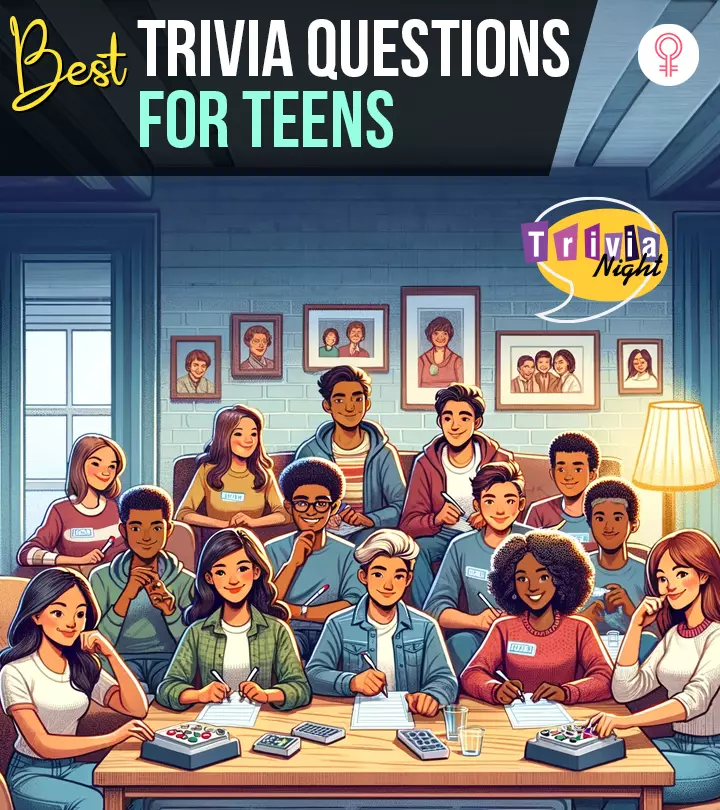16 Improv Games For Teens
Develop collaboration skills and have a great time in drama class with these improv games!

Image: Midjourney/ StyleCraze Design Team
It can sometimes be a challenge to manage and entertain teens. Most of them prefer to stay glued to their phones and video games, which affects their social functioning. Improv games for teens are the best way to make them come out of this. The games help them engage with their family and friends and keep them entertained.
With improv games, the teens explore different mock situations and improvise them, leading to more bonding and creative development. In addition, these games help the teens open up and learn team-building skills. Wondering which game to choose for your teenager? We can help. Here, we have a list of 15 improv games to get them off the couch and connect with others.
In This Article
Benefits Of Improv Games For Teens

Improv games offer many benefits for teens. It helps them develop essential life skills while having fun. Here are some of them:
1. It Enhances Creativity And Quick Thinking
Improv requires teens to think on their feet. It promotes creativity and the ability to come up with spontaneous ideas. It encourages thinking outside the box and improves problem-solving skills.
2. It Boosts Confidence
Performing in front of others, even in a playful context, can help teens build self-confidence. These games teach them to trust their instincts and express themselves freely without fear of judgment.
3. It Improves Communication Skills
Improv games rely heavily on effective communication, both verbal and non-verbal. Teens learn to listen actively, collaborate, and express their thoughts clearly. This strengthens their interpersonal skills and helps build better social interactions.
4. It Encourages Teamwork And Collaboration
Many improv games require working closely with others to create scenes or solve challenges. This promotes teamwork and the ability to adapt to other people’s ideas.
5. It Builds Resilience And Adaptability
Improv teaches teens to handle unexpected situations with a positive attitude. They learn to accept their mistakes as opportunities for growth and to stay flexible when things don’t go as planned.
6. It Strengthens Emotional Intelligence
Through role-playing and creating characters, teens explore different perspectives. This enhances their empathy and emotional intelligence. It helps them better understand their own feelings and those of others.
Overall, improv games help teens develop creativity, confidence, and communication skills, all while having fun!
Let us now go over to some of the best improv games of all time!
Key Takeaways
- Improv games are a great way to keep teenagers entertained during family game night.
- These games are based on ‘spur of the moment’ situations that teenagers can play around with.
- ’First Word, Last Word’ and ‘Eye The Selfie’ are some amazing improv games to get you started.
16 Best Improv Games For The Teens
Planning and hosting fun party games for teenagers can be a joy ride, given the creativity, energy, and competitive spirit they display. We are sure the following improv games will keep everyone in your teen party entertained.
1. Last Word, First Word
About The Game: This memory game encourages listening skills and helps develop team communication
. The objective is to improvise a story collectively.
How To Play: The participants sit in a circle. Scribble some random topics in paper chits, put them in a hat or bowl, and place it in the center. One player picks a topic and starts the story by reading the note. The next player has to start their sentence with the last word of the first player’s last sentence. This continues until the story is completed. Players have to build a possible story, and they are free to make it as absurd, weird, and fun as they can.
2. Musical Dilemma

About The Game: This game helps build memory and initiates quick thinking.
How To Play: The first player sings a line or two from any song. They then pick any random participant to continue the game. The second player has to sing a song that starts with any word from the first player’s song. To amp up the fun, you can set a timer for the next player to start. This is great to get all the participants singing the chorus and spending an entertaining and musical evening!
3. Changing Actions
About The Game: This game tests concentration levels and promotes memory retention.How To Play:
All participants sit in a circle with one player in the middle. The first player does some action, for example, clapping. The player then says “change” and does another action, like nodding. The moment the first player switches actions, the other participants have to repeat the previous action (clapping, in this case). The first player again switches action, and the rest have to do the previous action (nodding, in this case). Anyone who does the wrong action is out of the game. This continues until only one player is left. You can double the fun by choosing ridiculous actions like nose picking or ruffling the hair!
4. Number Words

About The Game: This game makes the participants get off their seats and be more active. It helps widen their vocabulary and creativity.
How To Play: Divide the participants into two groups. Both teams pick random scenarios to enact. Write down the numbers one to ten on paper chits and put them in a hat or bowl. Each member of the team picks a chit. Now, each team enacts the scenario, and the participants create dialogues. The condition is, each sentence in the dialogue should have no more than the allotted number of words. For example, if you have picked five, your sentences should have only five words. It is hilarious because the sentences must make sense and connect the story.
5. Dubbing
About The Game: This game helps teens to be expressive.How To Play:
Play a foreign language film and get each participant to improvise and speak out imaginary dialogues matching the scene playing on the screen. They cannot read out subtitles. It’s even more fun if the participants modulate their tones and try to enact the scenes themselves.
6. News Flash
About The Game: This game focuses on team-building skills.How To Play:
Participants are divided into teams, and each has a “news anchor” and a bunch of “reporters.” Play any random video on the monitor. The anchor is made to stand with their back toward the monitor. The reporters have to describe the scene to the news anchor, giving clues without directly mentioning what is happening on the screen. For instance, a scene with polar bears can allow a sentence like “it’s pretty cold up there.” The anchor has to form a news flash with these clues and guess the scene.
7. Sound Effects
About The Game:
This game has no rules and no winners or losers! It pushes the participants to get as creative as possible.
How To Play: This game involves acting. Participants can be divided into teams – one team for enacting a scene, another team for making sound effects, and another team to guess the scene.
The volunteer actors enact any random scenario, while the other volunteers provide sound effects to the scene. Now, here’s the twist – there are no limitations to the sounds one can make. For example, if the scene shows someone pulling a sword out, the sound effect could well be a “meow!” or anything unrelated to the action.
 Quick Tip
Quick TipThis makes the whole scene hilarious! It is an entertaining game to share some laughs.
8. Questions Only

About The Game: This game is best played in pairs and helps improve communication skills.
How To Play: Participants are paired up in teams and are given a topic for debate or to build up a conversation. The catch is – they can only use interrogative sentences and talk in questions, and the entire conversation has to make sense. Things can turn witty and hilarious!
9. Make Sentences

About The Game: We have all learned sentence construction in grammar class. This fun improv game takes it to another level of creativity.
How To Play: You will need a board or paper and a pen, and only one player gets to use them. The other players say random words, and the first player has to write them down. In the end, the first player has to form a sentence with all those words.
10. Prop Drop
About The Game:
This is a team game and taps on your “out-of-the-box” thinking.
How To Play: This game needs two teams, and each team gives specific props to the other. A member of the team picks a prop and uses it for a purpose other than its intended use. The idea is to use the props in the most creative, fun, and humorous way. For example, if the prop is a toothbrush, the actor can use it as a walking stick!
11. Drop The Ball
About The Game:
This game is an excellent icebreaker! It can help your teen to connect with others and have some fun.
How To Play: You will need a few cardboard boxes and ping pong balls. Tie the box to a player’s back and put the balls into it. The task is to drop all the balls within a stipulated time, without touching the box. The person can shake or jump to drop the balls. Whoever drops the maximum number of balls is the winner. But winning is not the fun part of this game… it’s watching everyone wriggle and jiggle!
12. Floating Feather
About The Game:
This is an entertaining game to keep everyone engaged.
How To Play: You will need a few colored feathers and some plastic straws. The players have to blow the feather up into the air and then use the straw to keep it from dropping. The player who can keep the feather floating the longest wins. You can set a time limit for each player. However, ensure to avoid collisions.
13. Twisted Dumb Charades
About The Game:
This is a fun and interactive game that demands the participants to express and emote.
How To Play: Divide the teens into two groups. One team gives another a proverb to enact. Like the classic dumb charade, the player uses signs and gestures to help the other team members guess the proverb. For each failed guess, the team gets an alphabet from the word “charades” on their scoreboard. The team that finishes the word “charades” first on their scoreboard loses!
14. Two Truths And A Lie
About The Game:
It can be used as an icebreaker and engage the teens and other family members in a fun and interactive way.
How To Play: Each player makes three statements about themselves – two of them should be true, and one must be a lie. The other players have to guess the lie. Whoever identifies the false statement gets the point. This is one of the most engaging family games to play and helps identify how much they know about each other. It is also an excellent way to bond with the teens.
15. Eye The Selfie

About The Game: How can you have an evening with teens without their phones or cameras? This game will require a phone or a digital camera or a polaroid.
How To Play: Each participant has to take a close-up picture of one of their eyes. The pictures are placed on a table in a sequence. You may take a print or place the mobile phone with the image on the screen. Every player has to recognize the eyes and write the person’s name as per the sequence. No one shares their answers until the end. The one with the maximum correct answers wins. To make it interesting, you can take the pictures from awkward angles.
16. Character Bus
About The Game:
This is a character improv game where three people at a time will sit on chairs, pretending they are inside a bus while the others will be audiences guessing who they are.
How To Play: Three participants at a time shall pick up paper slips with some characters that you typically see on a bus, described on them. For instance, a teenage student, a corporate worker, a doctor, etc. The participants then take their seats on the imaginary bus and act out the characters they picked, through dialogue or actions, for a predetermined amount of time. The audience has to guess what role they played. You can add more details to these characters, like their age, the name of an actor who has played such a role, and so on, to make it more challenging.
 Quick Tip
Quick TipImprovisation games are an excellent way to encourage teenage bonding. Teenage is a turbulent time when kids start transitioning into mature adults while still holding on to their child-like behaviors, and hence, insecurities, emotional changes, and complexes are rife. Therefore, it is crucial to help them get out of their cocoons, be creative and interactive, and gain confidence. The above list of improv games for teens can be great icebreakers and encourage them to improvise.
Infographic: Top 5 Improv Games For Teens
Today, teens are glued to their screens constantly, which can affect their social functioning. Since team building and communication skills are essential life skills, it is best to start nurturing these skills during the teen years. To help you out, we have rounded up 5 improv games that will help teens communicate and bond with one another in a fun way. Check out the infographic below to know more.

Illustration: StyleCraze Design Team
If your child is bored of the same old games of The Floor Is Lava, Tug Of War, or Hide And Seek, you may need some extra help to make them get out of the couch and engage in some physical activity. Improv games are the ideal solution for this issue as despite being the same game, every turn is different from the previous one. Therefore, there are endless possibilities of how the game might shape up. Furthermore, the improv games encourage your kids to think creatively and become more active.
Frequently Asked Questions
Can improv games be played indoors?
Yes, many of these improv games like musical dilemma, number words, eye the selfie, and many others can be adapted for indoor settings.
What is the #1 rule of improv?
The first rule of improv is to always go along with the shtick. For example, if in any of the improv games someone says “You are a monkey,” you have to act like a monkey. You improvise as the game progresses, but you always agree to what is happening.
What should you not do in improv?
You cannot say “no” in an improv. You should never ask open-ended questions as they can be too vague to answer. And don’t try to make every scene funny when you are doing improv. Just play out a scene naturally. Otherwise, it may look like you are trying too hard.
How to play the ‘What’s in the box?’ improv game?
Two players face each other. Player A mimes holding a box and offers it to player B. Player B asks, “What is in the box?” Player A says it is a gift and gives it to player B. Player B mimes opening the box and imagines what the gift is, saying something like, “Oh! It’s a gray wolf.” Then, player A has to come up with a reason for the gift. The players can switch roles in the next round.
How to play the ‘What happens next?’ improv game?
This game can be played with a big group of people. One person begins by acting out a story. The host of the game says “freeze,” and the person freezes. Then, the host asks the group of people what the person should do next. Once they decide the next step, the host unfreezes the person, and they continue the scene with the input from the remaining group. This keeps going until they reach the end. You can divide the group in two and keep adding players to a scene while the other group decides what happens in the scenes.
What makes a good scene in improv?
A good scene in improv is one that does not try too hard to be funny. The conversation and comedy in it flow easily. You can do that by making your partner look good when you see the opportunity. Don’t try to take all the laughs for yourself. Making your partner look good will showcase your skills.
What is blocking in improv?
Blocking in improv is when one player negates the suggestion of another player. It goes against the cardinal rule of improv, which is to always say “yes.” It stagnates the scene.
Watch this video to learn how to think on your feet and create something new with the game of “Yes, and…”.
Read full bio of Laura Silverstein
Read full bio of Sneha Tete
Read full bio of Asmita De


























Community Experiences
Join the conversation and become a part of our empowering community! Share your stories, experiences, and insights to connect with other beauty, lifestyle, and health enthusiasts.